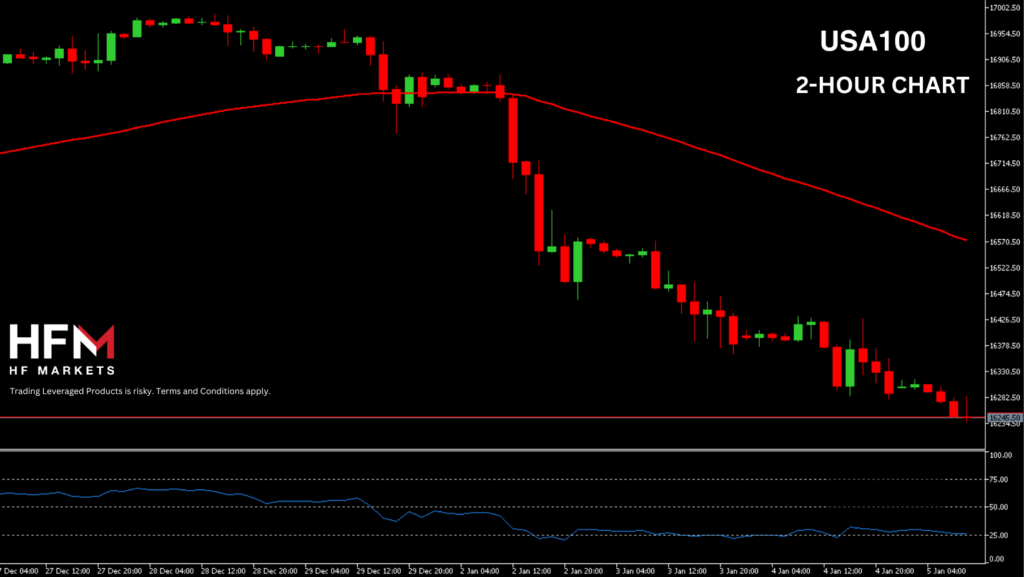- US employment data expected to influence US stocks, the Dollar, and Commodities.
- Analysts expect the US to have added a further 168,000 employed persons and the Unemployment rate to rise to 3.8%.
- The USA100 is close to completing its worst week in over 12 months as analysts expect rates to remain high.
- Analysts downgrade Apple and Tesla stocks, applying more pressure on the USA100.
The USA100 ended the day 0.65% lower and has now declined for a fourth consecutive day. Only the US30 was able to hold onto gains, but even the US30’s components struggled with 50% of the stocks ending the day lower. However, the US technology market rose consecutively for the last seven weeks of 2023, so many traders are now questioning why US stocks are struggling this week.
USA100 – Technology Stocks Decline Ahead of the US Employment Data Release!
This week the USA100 has fallen almost 3.70% which will be the largest decline since December 2022, unless the asset can regain some “lost ground” in this afternoon’s session. The downward price movement is largely due to the strong employment sector, which may keep rates higher for longer. In addition to this, expectations that certain companies are likely to underachieve in this quarter’s earnings weaken demand.
The Federal Open Market Committee’s Meeting Minutes signaled the central bank is likely to stick to a pause possibly until the second or third quarter of 2024. Nonetheless, the CM Exchange Fed Watch Tool indicates there is a 62% chance of a hike in March 2024. On the other hand, economists now advise this is unlikely. For this reason, technology stocks have come under pressure which may continue if this afternoon’s employment data reads stronger than current expectations.
Another negative factor is analysts downgrading influential tech stocks, such as Apple and Tesla. Due to this Apple stocks have fallen 6.30% this week and Tesla almost 10%. These two stocks alone hold 12.78% of the NASDAQ. Furthermore, Bond Yields again rose above 4.00% for the first time since dropping below this level. The 10-Year Bond Yield is up 0.023% this morning which could also possibly pressure stocks. Particularly if today’s Non-Farm Payroll figure reads higher than 175,000.
Of the top 20 most influential stocks within the USA100, only 7 held onto their value. This is not adequate to drive a bullish trend but is an improvement compared to Tuesday and Wednesday. However, of main importance will be the price movement after the release of the US employment data at 15:30 GMT+2.
In terms of technical analysis, the price is also seeing a decline due to consecutive increases which bring fears the asset is overpriced or not at a competitive entry level. Indicators continue to point towards a short-medium term downward price movement as it has since January 2nd. The price is trading below the “neutral” level on the RSI, below the VWAP and below the 75-bar-EMA. However, the asset has formed a bullish crossover on smaller timeframes meaning the price is not currently declining in the ultra-short term. If the price declines below $16,262.91, bearish signals may become active again.
Crude Oil – Oil Prices Rise as Tensions in the Middle East Remain High!
The price of Crude Oil is not seeing a clear direction as the NASDAQ has over the past month as well as this week. The asset is instead experiencing impulse waves and correction in both directions and most swings are “short-lived”. This is due to investors believing the asset is trading around its true value based on currency market conditions. However, plenty of volatility continues to provide signals for short-term trades.
The commodity is supported by certain factors from the past 24 hours such as the closing of the Libyan oil production market and fields for the day. Also, the price is supported by tension rising in the middle east after explosions in Iran by Islamic State Terrorists. However, similarly to all commodities and tradable assets, Crude Oil will largely be influenced by today’s NFP data. If the data triggers a more expensive Dollar and lower risk appetite, oil prices could potentially decline. Whereas a weaker Dollar is known to support oil prices. Nonetheless, traders should be cautious of volatility and unorthodox price movements.
Click here to access our Economic Calendar
Michalis Efthymiou
Market Analyst
Disclaimer: This material is provided as a general marketing communication for information purposes only and does not constitute an independent investment research. Nothing in this communication contains, or should be considered as containing, an investment advice or an investment recommendation or a solicitation for the purpose of buying or selling of any financial instrument. All information provided is gathered from reputable sources and any information containing an indication of past performance is not a guarantee or reliable indicator of future performance. Users acknowledge that any investment in Leveraged Products is characterized by a certain degree of uncertainty and that any investment of this nature involves a high level of risk for which the users are solely responsible and liable. We assume no liability for any loss arising from any investment made based on the information provided in this communication. This communication must not be reproduced or further distributed without our prior written permission.





















